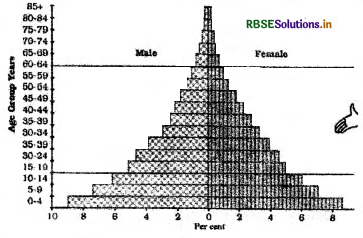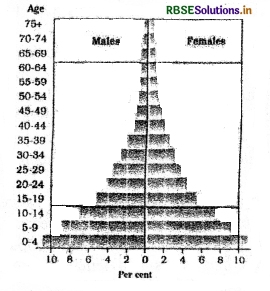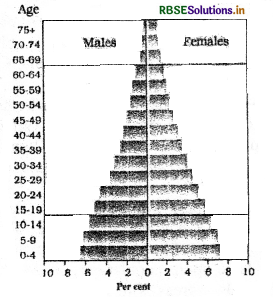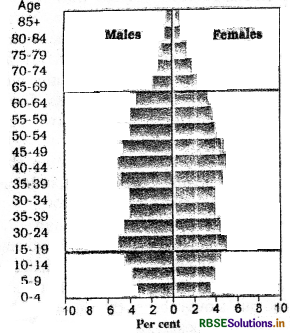RBSE Class 8 Social Science Important Questions Geography Chapter 6 Human Resource
Rajasthan Board RBSE Class 8 Social Science Important Questions Geography Chapter 6 Human Resource Important Questions and Answers.
Rajasthan Board RBSE Solutions for Class 8 Social Science in Hindi Medium & English Medium are part of RBSE Solutions for Class 8. Students can also read RBSE Class 8 Social Science Important Questions for exam preparation. Students can also go through RBSE Class 8 Social Science Notes to understand and remember the concepts easily. Go through these class 8 history chapter 6 questions and answers in hindi and get deep explanations provided by our experts.
RBSE Class 8 Social Science Important Questions Geography Chapter 6 Human Resource
Multiple Choice Questions
Question 1.
In which year, the Ministry of Human Resource Development was created under the Government of India?
(a) 1975
(b) 1985
(c) 1995
(d) 2005
Answer:
(b) 1985
Question 2.
In a nation, the greatest resource is
(a) People
(b) Animal
(c) Machines
(d) Teachers
Answer:
(a) People
Question 3.
90 percent of the world’s population lives in about how much area of the land surface?
(a) 5 percent
(b) 30 percent
(c) 15 percent
(d) 20 percent
Answer:
(b) 30 percent
Question 4.
The maximum population of the world lives on which continent?
(a) Australia
(b) Europe
(c) North America
(d) Asia
Answer:
(d) Asia

Question 5.
Population density means
(a) people living per square km
(b) people living 10 km
(c) people living 50 km
(d) people living 100 km
Answer:
(a) people living per square km
Question 6.
Factor affecting the population is
(a) Geographical factor
(b) Economic factor
(c) Social factor
(d) All of the above
Answer:
(d) All of the above
Question 7.
The geographical factors affecting the population include
(a) Climate
(b) Soil
(c) Water
(d) All of the above
Answer:
(d) All of the above
Question 8.
The birth rate is measured as
(a) number of live births per 500 people
(b) number of live births per 1000 people
(c) number of live births per 1500 people
(d) number of live births per 2000 people
Answer:
(b) number of live births per 1000 people
Question 9.
At the beginning of 1959, what was the population of the world?
(a) 1 billion
(b) 2 billion
(c) 3 billion
(d) 4 billion
Answer:
(c) 3 billion
Question 10.
What is the average density per square km of the population in India?
(a) 250 people
(b) 310 people
(c) 382 people
(d) 380 people
Answer:
(c) 382 people

Fill in the blanks
Question 1.
The way in which people are spread across the earth's surface is known as the pattern of population.................
Answer:
distribution
Question 2.
The maximum population of the world lives in .................continent.
Answer:
Asia
Question 3.
The average density of population in the whole world is................. persons per square km.
Answer:
51
Question 4.
.................refers to a change in the number of people during a specific time.
Answer:
Population change
Question 5.
The movement of people in and out of an area is called .................
Answer:
migration
Question 6.
The difference between the birth rate and the death rate of a country is called the.................
Answer:
natural growth rate
State True or False
Question 1.
Human resource is the ultimate resource.
Answer:
True
Question 2.
Maximum population m the world lives in North America continent.
Answer:
False
Question 3.
The plains of the Nile river in China are densely populated
Answer:
False
Question 4.
In the United Kingdom, population growth is slowing because of both low death and low birth rates.
Answer:
True
Question 5.
Births and deaths are the natural causes of population change.
Answer:
True

Match Correctly
|
(a) |
(b) |
|
(Percentage of world’s total population) |
(Living area) |
|
1percent |
Europe |
|
5percent |
North America |
|
8percent |
Central and South America |
|
12percent |
Asia |
|
13percent |
Africa |
|
61percent |
Oceania |
Answer:
|
(a) |
(b) |
|
(Percentage of world’s total population) |
(Living area) |
|
1percent |
Oceania |
|
5percent |
North America |
|
8percent |
Central and South America |
|
12percent |
Europe |
|
13percent |
Africa |
|
61percent |
Asia |
Very Short Answer Type Questions
Question 1.
Why the Government of India created the Ministry of Human Resource Development.
Answer:
The Government of India created the Ministry of Human Resource Development to improve people’s skill.
Question 2.
What is population distribution?
Answer:
The way in which people are spread across the earth's surface is known as population distribution.
Question 3.
Which resource is the ultimate resource?
Answer:
Human resource is the ultimate resource.
Question 4.
Which country has the maximum population, in the world?
Answer:
In the world, the maximum population is in China
Question 5.
On the basis of population, what is the place India in the world?
Answer:
On the basis of population, India holds the second position in the world.
Question 6.
What is population density?
Answer:
The number of people living in the unit area of the earth’s surface is called population density.
Question 7.
What is the population density of India?
Answer:
Average density of population in India is 382 persons per square km.
Question 8.
Name any two geographical factors that affect the distribution of population.
Answer:
- Topography
- Climate.
Question 9.
What is life expectancy?
Answer:
It is the number of years that an average person can expect to live.
Question 10.
What is birth rate?
Answer:
The measure of the number of live births per 1000 people is called birth rate.
Question 11.
What is death rate?
Answer:
Death rate is the number of deaths per 1000 people.
Question 12.
What is natural growth rate?
Answer:
The difference between the birth rate and the death rate of the country is called the natural growth rate.
Question 13.
What do you mean by emigration and immigration?
Answer:
Emigrants are people who leave a country whereas immigrants are those who arrive in a country.
Question 14.
Name two countries that have gained in numbers by immigration.
Answer:
- the United States of America
- Australia.
Question 15.
If birth rate is less than death rate, how it will affect the population?
Answer:
If birth rate is less than death rate, population growth will slow down.
Short Answer Type Questions
Question 1.
What is the need for human resource?
Answer:
Human is an important resource for a country because human is the only resource that makes natural resources usable by its skill and ability. Man, by his abilities and needs, transforms the gift of nature into a resource. Healthy, educated and motivated people develop resources according to their needs. In this way, human resource is most useful and is the ultimate resource.
Question 2.
Write a short note on the distribution of population in the world.
Answer:
The distribution of population in the world is extremely uneven. More than 90 percent of the world’s population lives in about 30 percent of the land surface. Some areas of the world are very crowded whereas some are sparsely populated. Almost three-quarters of the world’s people live in two continents Asia and Africa. Sixty percent of the world’s people stay in just 10 countries.
Question 3.
Explain the density of population in the world.
Answer:
Population density is the number of people living in a unit area of the earth’s surface. It is normally expressed as per square km. The average density of population in the whole world is 51 persons per square km. South Central Asia has the highest density of population followed by East and South East Asia. Average density of population in India is 382 persons per square km.
Question 4.
Discuss any two geographical factors that affect the distribution of population.
Answer:
(1)Soil:
Fertile soils provide suitable land for agriculture. Fertile plains such as Ganga and Brahmaputra in India, Hwang-He, Chang Jiang in China and the Nile in Egypt are densely populated.
(2) Water:
People prefer to live in the areas where freshwater is easily available. The river valleys of the world are densely populated while deserts have spread population.
Question 5.
Discuss the economic and cultural factors that affect the distribution of population.
Answer:
Cultural:
Places with religion or cultural significance attract people. Varanasi, Jerusalem and Vatican city are some examples.
Economic:
Industrial area provide employment opportunities. Large number of people are attracted to these areas. Osaka in Japan and Mumbai in India are two densely populated areas.
Question 6.
Write a note on population change in world.
Answer:
The population change refers to change in the number of people during a specific time. The world population has not been stable as it has increased manifold. Until the 1800s, the world’s population grew steadily but slowly. In 1804, the world’s population reached one billion. A hundred and fifty five years later, in 1959, the world’s population reached 3 billion. In 1999, 40 years later, the population doubled to 6 billion.
Question 7.
Explain any three factors that affect the population change.
Answer:
(1) Birth rate:
Birth rate refers to the measure of the number of live births per 1,000 people. The country with high birth rate has high growth rate.
(2) Death rate:
Death rate refers to the measure of the number of deaths per 1,000 people. The country with low death rate and high birth rate, their population growth is high.
(3) Migration:
When people leave a country, it is called emigration, this leads to decrease in population. When people arrive in a country, it is called immigration, which leads to rise in population of that country

Question 8.
What do you know about the Pradhan Mantri Kaushal Vikas Yojna (PKVY).
Answer:
Pradhan Mantri Kaushal Vikas Yojna (PKVY) was started in 2015 aiming to train one crore Indian youth from 2016 to 2020. The objective of this scheme is to encourage aptitude towards employable skills by giving quality training to probable and existing wage earners.
Long Answer Type Questions
Question 1.
What do you mean by distribution of population? Explain the factors that affect the distribution of population.
Answer:
Population distribution:
The way in which people are spread across the earth surface is known as population distribution. The distribution of population in the world is extremely uneven. Factors affecting distribution of population.
The main factors that affect the distribution of population are as follows:
(a) Geographical Factors:
1. Topography:
People always prefer to live on plains rather than mountains and plateaus because these areas are suitable for farming, manufacturing and service activities. The Ganga plains are the most densely populated areas of the world while mountains like Andes, Alps and Himalayas are sparsely populated.
2.Climate:
People usually avoid extreme climates that are very hot or very cold like Sahara desert, polar regions of Russia, Canada and Antarctica.
3. Soil:
Fertile soils provide suitable land for agriculture. Fertile plains such as Ganga and Brahmputra in India, Hwang-He, Chang Jiang in China and the Nile in Egypt are densely populated.
4. Water:
People prefer to live, in the areas where fresh water is easily available. The river valleys of the world are densely populated while deserts have spare population.
5. Minerals:
Areas with mineral deposits are more populated. Diamond mines of South Africa and discovery of oil in the Middle east lead to setting of people in these areas.
(b) Social Factors:
Areas of better housing, education and health facilities are more densely populated e.g., Pune.
(c) Cultural Factors:
Places with religion or cultural significance attract people. Varanasi, Jerusalem and Vatican city are some examples.
(d) Economic Factors:
Industrial areas provide employment opportunities. Large number of people are attracted to these areas. Osaka in Japan and Mumbai in India are two densely populated areas.

Question 2.
Explain, the state of population change in the world. Explain the factors influencing population change.
Answer:
State of population change in the world:
Population change refers to change in the number of people during a specific time. Until the 18O0s, the. world’s population grew steadily but slowly because before that there were no proper health facilities and death rate were also high in the world. In 1804, the world’s population reached one billion. A hundred and fifty five years later, in 1959, the world’s population reached 3 billion.
In 1999, the population doubled to 6 billion, which was double the population of 1959. Therefore, after 1800, the world population has increased at a rapid pace. Factors affecting population change.
The following three factors mainly affect the population change:
(1) Birth rate:
Birth rate is the measure of the number of live births per 1000 persons. In a country where the birth rate is very high, its population grows at a rapid pace.
(2) Death rate:
Death rate is the measure of the number of deaths per 1000 people. If the death rate in a country is very low and if the birth rate is high, the population of that country will increase at a rapid pace.
(3) Migration:
The movement of people in and out of an area is called migration. Migration is another way by which population size changes. People may move within a country or between countries. Emigrants are people who have a country. This reduces the population of the country. Immigrants are people who arrive in a country. This increases the population of the country.
Question 3.
What do you understand by population pyramid? Explain the population pyramids of different situations with the help of diagram.
Answer:
Population pyramid To study the population composition of a country, the population pyramid is used. It is also called an age-sex pyramid. The population pyramid is a graphical representation of the age-sex composition of a population.
A population pyramid shows:
The total population divided into various age groups, e.g., 5 to 9 years, 10-14 years.
The percentage of the total population, subdivided into males and females, in each of those groups.
The shape of the population pyramid explains the age group and sex ratio status of the people living in that particular country. The population pyramid can be represented by the following diagram

Population Pyramid
Figure 1 shows the number of children in the lower part of the pyramid (below 15 years), the number of older people in the upper part of the pyramid (over 65 years), and the working population (15 years to 65 years) in the middle part of the pyramid.
Population pyramids of different positions can be explained with the help of population pyramids of Kenya, India and Japan.
(1) Figure 2 is the population pyramid of Kenya. It shows that many children are bom here (broad base) but a large percentage of them die in their infancy. As a result, there are very few old people (narrow peak).

Population Pyramid of Kenya
(2) Figure 3 is the population pyramid of India. This shows that more infants survive to adulthood as compared to Kenya. Such population contains a large number of young people which is called working population.

Population Pyramid of India
(3) Figure 4 is the population pyramid of Japan. The base of the pyramid is narrow7 which shows that the infant birth rate is low. Decreased death rate allows numbers of people to reach old age.

Population Pyramid of Japan

- RBSE Class 8 Social Science Important Questions History Chapter 3 Ruling the Countryside
- RBSE Solutions for Class 8 Social Science Geography Chapter 1 Resources
- RBSE Class 8 Social Science Notes in Hindi & English Medium Pdf Download
- RBSE Class 8 Social Science Important Questions in Hindi & English Medium
- RBSE Solutions for Class 8 Social Science in Hindi Medium & English Medium
- RBSE Class 8 Social Science Notes History Chapter 1 How, When and Where
- RBSE Class 8 Social Science Important Questions Civics Chapter 9 जनसुविधाएँ
- RBSE Solutions for Class 8 Social Science Civics Chapter 10 कानून और सामाजिक न्याय
- RBSE Class 8 Social Science Important Questions Civics Chapter 10 कानून और सामाजिक न्याय
- RBSE Solutions for Class 8 Social Science Civics Chapter 9 जनसुविधाएँ
- RBSE Class 8 Social Science Important Questions Civics Chapter 8 हाशियाकरण से निपटना